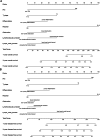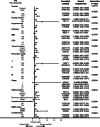Combining perineural invasion with staging improve the prognostic accuracy in colorectal cancer: a retrospective cohort study
- PMID: 37464346
- PMCID: PMC10354907
- DOI: 10.1186/s12885-023-11114-8
Combining perineural invasion with staging improve the prognostic accuracy in colorectal cancer: a retrospective cohort study
Abstract
Background: Current guidelines only propose the importance of perineural invasion(PNI) on prognosis in stage II colon cancer. However, the prognostic value of PNI in other stages of colorectal cancer (CRC) is ambiguous.
Methods: This single-center retrospective cohort study included 3485 CRC patients who underwent primary colorectal resection between January 2013 and December 2016 at the Sixth Affiliated Hospital of Sun Yat-sen University. Associations of PNI with overall survival (OS) and disease-free survival (DFS) were evaluated using multivariable Cox proportional hazards regression models. In addition, interaction analyses were performed to explore the prognostic effects of PNI in different clinical subgroups.
Results: After median follow-up of 61.9 months, we found PNI was associated with poorer OS (adjusted hazard ratio [aHR], 1.290; 95% CI, 1.087-1.531) and DFS (aHR, 1.397; 95% CI, 1.207-1.617), irrespective of tumor stage. Interestingly, the weight of PNI was found second only to incomplete resection in the nomogram for risk factors of OS and DFS in stage II CRC patients. Moreover, OS and DFS were insignificantly different between stage II patients with PNI and stage III patients (both P > 0.05). PNI was found to be an independent prognostic factor of DFS in stage III CRC (aHR: 1.514; 95% CI, 1.211-1.892) as well. Finally, the adverse effect of PNI on OS was more significant in female, early-onset, and diabetes-negative patients than in their counterparts (interaction P = 0.0213, 0.0280, and 0.0186, respectively).
Conclusion: PNI was an important prognostic factor in CRC, more than in stage II. The survival of patients with stage II combined with perineural invasion is similar with those with stage III. PNI in stage III CRC also suggests a worse survival.
Keywords: Colorectal cancer; Perineural invasion; Survival; Tumor stage.
© 2023. The Author(s).
Conflict of interest statement
The authors declare no competing interests.
Figures




Similar articles
-
The depth of perineural invasion is an independent prognostic factor for stage II colorectal cancer.BMC Cancer. 2024 Apr 8;24(1):433. doi: 10.1186/s12885-024-12206-9. BMC Cancer. 2024. PMID: 38589842 Free PMC article.
-
Lymphovascular invasion represents a superior prognostic and predictive pathological factor of the duration of adjuvant chemotherapy for stage III colon cancer patients.BMC Cancer. 2023 Jan 3;23(1):3. doi: 10.1186/s12885-022-10416-7. BMC Cancer. 2023. PMID: 36593480 Free PMC article.
-
Clinical implications of perineural invasion in patients with colorectal cancer.Medicine (Baltimore). 2020 Apr;99(17):e19860. doi: 10.1097/MD.0000000000019860. Medicine (Baltimore). 2020. PMID: 32332645 Free PMC article.
-
Prognostic value of perineural invasion in colorectal cancer: a meta-analysis.J Gastrointest Surg. 2015 Jun;19(6):1113-22. doi: 10.1007/s11605-015-2761-z. Epub 2015 Feb 7. J Gastrointest Surg. 2015. PMID: 25663635 Review.
-
What is the impact of perineural invasion on the prognosis of cervical cancer: a systematic review and meta-analysis.BMC Cancer. 2025 Mar 17;25(1):491. doi: 10.1186/s12885-025-13838-1. BMC Cancer. 2025. PMID: 40098102 Free PMC article.
Cited by
-
Prognostic value of positive lymph node ratio, tumor deposit, and perineural invasion in advanced colorectal signet-ring cell carcinoma.Front Mol Biosci. 2025 Aug 1;12:1617787. doi: 10.3389/fmolb.2025.1617787. eCollection 2025. Front Mol Biosci. 2025. PMID: 40821700 Free PMC article.
-
Primary and secondary metastatic dissemination: multiple routes to cancer-related death.Mol Cancer. 2025 Jul 22;24(1):203. doi: 10.1186/s12943-025-02389-5. Mol Cancer. 2025. PMID: 40696378 Free PMC article. Review.
-
Spectral CT in the evaluation of perineural invasion status in rectal cancer.Jpn J Radiol. 2024 Sep;42(9):1012-1020. doi: 10.1007/s11604-024-01575-7. Epub 2024 May 6. Jpn J Radiol. 2024. PMID: 38709434
-
The depth of perineural invasion is an independent prognostic factor for stage II colorectal cancer.BMC Cancer. 2024 Apr 8;24(1):433. doi: 10.1186/s12885-024-12206-9. BMC Cancer. 2024. PMID: 38589842 Free PMC article.
References
MeSH terms
LinkOut - more resources
Full Text Sources
Medical

